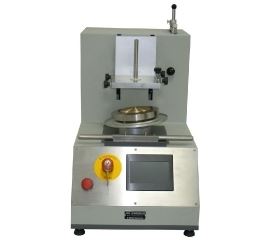Schopper Abrasion & Wear Tester
How the Schopper Abrasion and Wear Tester Works
The tester operates on the principle of rotary friction, where a specimen is subjected to controlled abrasion from a standardized abrasive (e.g., sandpaper, wool felt, or a rubber wheel). Key features include:
- Adjustable Parameters: Speed (up to 60 rpm), load pressure (typically 5–12 N), and abrasion cycles.
- Specimen Clamping: Materials are secured in a circular holder, ensuring even contact with the abrasive surface.
- Measurement: The number of cycles required to achieve visible wear, such as coating removal or fiber breakage, determines the material’s durability rating.
Compliance with standards like ISO 5470-1, ASTM D3884, and DIN 53863 ensures consistent results across laboratories. Advanced models integrate digital counters and automated shut-off functions for precision.

Applications Across Industries
- Textiles and Apparel: Tests the abrasion resistance of fabrics used in denim, upholstery, and protective gear, ensuring compliance with safety norms like EN ISO 12947.
- Automotive Interiors: Evaluates leather and synthetic materials for car seats, dashboards, and steering wheels to withstand long-term friction.
- Footwear Manufacturing: Assesses sole and upper material durability, aligning with SATRA TM31 standards.
- Coatings and Paints: Measures the scratch resistance of industrial coatings, aiding in R&D for anti-scratch finishes.
Market Significance and Future Trends
As industries prioritize sustainability and cost-efficiency, the Schopper Abrasion and Wear Tester has become indispensable for reducing material waste and enhancing product lifespans. Manufacturers like James Heal and SDL Atlas offer cutting-edge models with features like 3D imaging for real-time wear analysis and AI-driven predictive modeling to forecast material longevity.
The growing demand for eco-friendly materials—such as recycled polymers and bio-based coatings—is driving innovations in testing methodologies. Future machines may incorporate IoT connectivity for remote monitoring and cloud-based data analytics, streamlining workflows for global testing labs.
In conclusion, the Schopper Abrasion and Wear Tester is a cornerstone of material science, bridging innovation and practicality. By investing in this technology, businesses not only meet regulatory standards but also gain a competitive edge in an era of heightened quality expectations.

